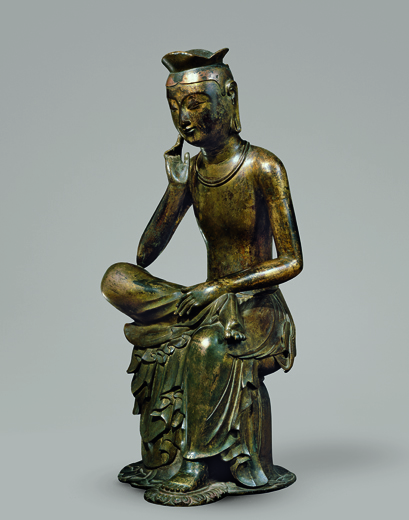Discovering Korea’s Golden Kingdom at The Met with its Curators
by Lisa Chung
The first exhibition of its kind in the West, Silla: Korea’s Golden Kingdom at The Metropolitan Museum of Art traces the dynasty from its small beginnings to its rise as a powerful kingdom with the display of more than 130 artifacts.
Written about in both Arabic and Japanese historical documents, Silla was described as a mysterious land of gold in the Far East, says Denise Leidy, one of the curators. The first exhibition of its kind in the West, Silla: Korea’s Golden Kingdom at The Met traces the dynasty from its small beginnings to its rise as a powerful kingdom with the display of more than 130 artifacts, many of which are designated National Treasures or Treasures in Korea.

Bodhisattva in pensive pose, probably Maitreya (Korean: Mireuk). Korea, Silla kingdom, late 6th–early 7th century. Gilt bronze; H. 36 7/8 in. (93.5 cm). National Museum of Korea, National Treasure 83
The Silla exhibition curators Leidy and Soyoung Lee were joined on Feb. 12 at the museum’s Bonnie J. Sacerdote Lecture Hall by Korean-American playwright Young Jean Lee to discuss the exhibition’s key pieces, as part of Spark, a conversation series titled Korea: From Silla to K-Pop.
The kingdom’s architecture and buildings, which are no longer in existence, were adorned with gold, and the written history from 11th to 12th century Silla reveals the kingdom’s contact with outsiders, as witnessed through one of the exhibition pieces excavated from a tomb: a Medieval dagger with the largest version of metal working, which can be traced to Western Europe.
“Modern day excavation showed us that Korea was very much part of that Eurasia,” Soyoung says.
As Korea shifted focus to a Buddhist kingdom, its material culture also changed. Existing art and jewelry were re-purposed to make Buddhist art. Many of the pieces displayed in the exhibition were spirit goods excavated from tombs, revealing the belief in an after-life.
It was common to bury regal items like a gold crown and figurines of servants or of foreigners, with important figures, Leidy says. Being buried with figurines of foreigners showed your sophistication, she adds.
Young Jean, a New York-based playwright, said though she rarely has emotional connections with artifacts similar to those in the exhibit, one of the pieces struck a chord with her. At approximately 3-feet tall, the gilt bronze statue of Bodhisattva captures both the understanding of religion and the artistic skill of its maker. The detail in the hands and feet make the figure feel accessible.
This statue, Soyoung says, is the “Mona Lisa of Korean art.”
Silla: Korea’s Golden Kingdom is on view now through Sunday, Feb. 23 at Special Exhibition Gallery on the first floor of The Metropolitan Museum.
Enjoyed this article?
Uncover more reviews of top events and be the first to know about new lectures by signing up for Thought Gallery for free. Click here to sign up.
